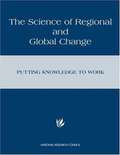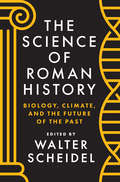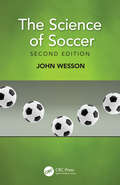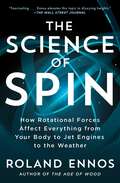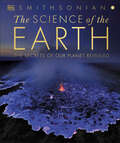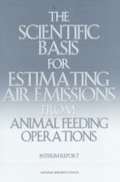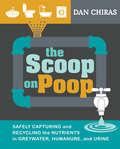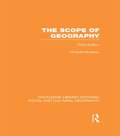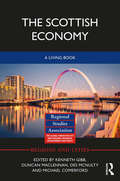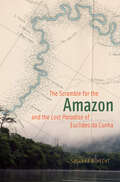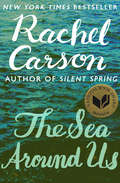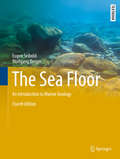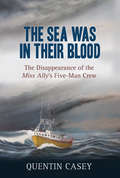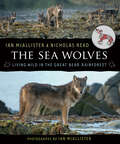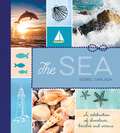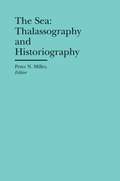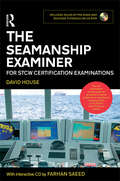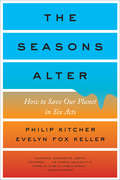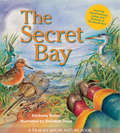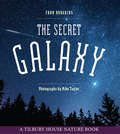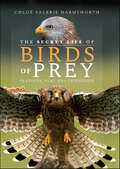- Table View
- List View
The Science of Regional and Global Change: PUTTING KNOWLEDGE TO WORK
by National Research CouncilThis report is intended to promote a dialogue between the scientific community and the government officials who will lead our nation in the coming years on global change research. The first section of the report is a brief description of the challenges and proposed responses needed from the highest levels of the government and the second provides more detailed discussion and is directed to agency-level issues and responses. The last section is a detailed bibliography that lists many of the specific reports on which the views outlined here are ultimately based.
The Science of Roman History: Biology, Climate, and the Future of the Past
by Walter ScheidelHow the latest cutting-edge science offers a fuller picture of life in Rome and antiquity. <p><p>This groundbreaking book provides the first comprehensive look at how the latest advances in the sciences are transforming our understanding of ancient Roman history. Walter Scheidel brings together leading historians, anthropologists, and geneticists at the cutting edge of their fields, who explore novel types of evidence that enable us to reconstruct the realities of life in the Roman world. <p><p>Contributors discuss climate change and its impact on Roman history, and then cover botanical and animal remains, which cast new light on agricultural and dietary practices. They exploit the rich record of human skeletal material—both bones and teeth—which forms a bio-archive that has preserved vital information about health, nutritional status, diet, disease, working conditions, and migration. Complementing this discussion is an in-depth analysis of trends in human body height, a marker of general well-being. <p><p>This book also assesses the contribution of genetics to our understanding of the past, demonstrating how ancient DNA is used to track infectious diseases, migration, and the spread of livestock and crops, while the DNA of modern populations helps us reconstruct ancient migrations, especially colonization. <p><p>Opening a path toward a genuine biohistory of Rome and the wider ancient world, The Science of RomanHistory offers an accessible introduction to the scientific methods being used in this exciting new area of research, as well as an up-to-date survey of recent findings and a tantalizing glimpse of what the future holds.
The Science of Soccer
by John WessonUpdated and revised throughout, this new edition of The Science of Soccer applies scientific analysis to football, giving us the answers to questions like "what's the chance of a team that wins the Premiership also winning the Cup? Can you predict how many goals will be scored? What's the best height for footballers? Is the team that wins the league the best team?" Starting with a qualitative description of the basic physics that relate to the ball and its bounce, the author then moves through kicks and throws, to a simple account of the more complex physics of a ball in flight. Fulfilling your scientific curiosity, this book uncovers aspects of the game that are not normally discussed. It includes a look at game theory, how the rules affect the flow and enjoyment of the game, unusual statistics about players, and an insight into the economics of the game. For those with a more mathematical interest in the physics, the final chapter provides a readable account of the theory behind the beautiful game. Features: Accessible to anyone interested in understanding more about the science behind the sport Updated throughout, with new content on transfer fees, wages, and the top goal-scorers Discusses topics not explored in current literature, including rudimentary game theory
The Science of Spin: How Rotational Forces Affect Everything from Your Body to Jet Engines to the Weather
by Roland EnnosA clear and captivating work of popular science that explains rotational force—a basic driver of the universe affecting everything from the cosmos to our own bodies—from the masterful author of The Age of Wood.From the time women first used rotating bobbins to twist thread and men whirled slings around their heads to throw stones, people have found spin fascinating and baffling in equal measure. Now, in The Science of Spin, Roland Ennos shows how rotational motion dominates the workings of the world around us. It has shaped the solar system, galaxies, and black holes. It controls our climate and weather—from the pattern of trade winds through to the local formation of hurricanes and tornadoes. Harnessing the power of spin helped launch civilization, from the first developments of the wheel to the systems that now power the industrial world—propellers, turbines, centrifugal pumps, and electric motors. Even our own bodies are complex systems of rotating joints and levers. But scientists have a tendency to ignore the simple and straightforward. So, 17th-century scientists developed the science of mechanics to explain the phenomenon of the orbit of the planets rather than how machines work. And Newton&’s laws have actually limited our understanding of spin because they focus on linear motion rather than on an intuitive grasp of rotation. As a result, few people realize how spin makes our planet habitable, or how it has been tamed by engineers to make our lives more comfortable. In a lively and engaging style, Ennos presents a new approach to mechanics that not only helps us better understand the world, but also reveals unlikely links between tightrope walkers and tyrannosaurs, catapults and tennis players, stunt cars and long jumpers. By opening our minds, he shows how we can all learn to move about more gracefully, play sports more successfully and safely—and ensure that, like cats, we always land on our feet. A highly entertaining and informative read, whether it be natural or engineered, spin is what really makes the world go round.
The Science of the Earth: The Secrets of Our Planet Revealed
by DKExplore the Earth&’s natural riches with this beautiful book that brings every corner of the planet, from core to atmosphere, to life!Introducing The Science of Earth - an informative, visually arresting introduction to planet Earth. Did you know that bubbles of ancient air trapped inside the Antarctic ice core can reveal how Earth&’s climate has changed over time? Or that a piece of pumice thrown several miles into the air by a volcano helps to explain what happens when tectonic plates collide? Well, now you do! Learn all about our weird and wonderful planet with The Science of Earth. The core of the book features large, detailed photographs of single objects, many of them small enough to be held in the hand, that each speaks volumes about an aspect of Earth&’s environments and how they work. Structured around an imaginary journey that takes the reader from the inner core to Earth&’s surface (including both land and oceans) and up to the top of the atmosphere, whilst taking in environments such as grasslands, forests, and reefs, the coverage includes both living and inanimate realms!Dive deep into the pages of this awe-inspiring book on Planet Earth to discover: - Spotlights showcasing celebrated sites, such as the Grand Canyon, Mount Everest, and the Great Barrier Reef- Easy-to-read explanations of large-scale Earth processes, such as weather systems and oceanic currents- Study of Earth segments look at breakthroughs our understanding of how the planet worksMany of the most beautiful parts of the natural world are beyond reach, but with fascinating feature pages throwing a spotlight on iconic places, such as the Amazon Rainforest or the Dead Sea, or a particular process, such as glacial erosion - this beautifully informative natural history book truly brings them to life.A must-have volume for readers interested in geography, geology, oceanography, meteorology, ecology, or the natural world in general, so whether you have a passion for landscape photography, or you&’re a frequent watcher of TV documentaries such as Our Planet, Blue Planet II, and Planet Earth - The Science of Earth is a great addition to the bookshelf of both schools and libraries alike, doubling up as the perfect gift purchase for anyone interested in the natural world.
The Scientific Basis for Estimating Air Emissions from Animal Feeding Operations
by Ad Hoc Committee on Air Emissions from Animal Feeding OperationsThis is an interim report of the Ad Hoc Committee on Air Emissions from Animal Feeding Operations of the National Research Council's Committee on Animal Nutrition. The report focuses on identifying the scientific criteria needed to ensure that estimates of air emission rates are accurate, examining the basis for these criteria in the scientific literature, and assessing uncertainties associated with them. There is no subject index. Annotation (c)2003 Book News, Inc. , Portland, OR (booknews. com)
The Scoop on Poop
by Dan ChirasFlush it and forget it is the plumbing mantra of the industrialized world. Most people just want sewage to go away, preferably without having to see, smell, or worse yet, touch it. But crap has a bad rap. Human waste is a valuable resource we can use to support food production. Blackwater, greywater, and solids are actually rich in organic matter, and alternative means of handling these "wastes" can conserve enormous quantities of fresh water for other uses.The Scoop on Poop presents a wide range of ways to answer the call of nature, and in so doing to maximize the benefits of existing waste water. This book explores proven alternatives to Western sanitation. Whether you're interested in composting toilets, outdoor grey- or blackwater planters, constructed wetlands, or other innovative solutions, author Dan Chiras will walk you through: System pros and cons Design, construction, and maintenance advice Costs, permitting issues, and the safe treatment of composted wasteAll system plans are relatively simple and straightforward enough for the average homeowner to build and install. Intended for readers who live in cities, towns and rural environments, this is a practical guide to safe, ingenious ways to capture the nutrients from waste and recycle them back into your soil to grow fruit trees, vegetables, and flowers--all without running afoul of the "ick" factor. Dan Chiras is the author of over thirty books on residential renewable energy and green building, and is the director of the Evergreen Institute's Center for Renewable Energy and Green Building.
The Scope of Geography (Routledge Library Editions: Social and Cultural Geography)
by Rhoads MurpheyThis book introduces the beginning student to the major concepts, materials and tools of the discipline of geography. While it presents geographic theory, as whole and for each of its parts, the chief emphasis is on concrete analysis and example rather than on abstraction, an approach which has proven more successful for undergraduate courses than those with a more heavily theoretical bias. The text was extensively re-written for the third edition, which enhanced its clarity and effectiveness, with expanded cartographic coverage.
The Scottish Economy: A Living Book (Regions and Cities)
by Duncan Maclennan Kenneth Gibb Des Mcnulty Michael ComerfordThe Scottish economy is at the heart of contemporary constitutional and public policy debates. This substantial new edited collection, the first comprehensive and authoritative analysis for more than 60 years, is a timely update on the classic volume of the same name edited by Sir Alec Cairncross in 1954. It is data rich, and offers links to updatable data and leading indicators of the Scottish economy including measures of public finances, distributional evidence and growth. Readers will find a series of easy to follow chapters covering the Scottish economy from every angle – oil and gas, health, education, finance, rural Scotland, inequality, climate change, gender and work, housing, infrastructure and cities. Each sector-based chapter explores the main issues, draws out key empirical facts and considers policy challenges that lie ahead. This book includes: an historical account of the development of the Scottish economy; the trajectory of economic policy in Scotland; reviews of the current fiscal position and the wider economic landscape; and also an intriguing insight into the emerging distinctive approach to Scottish public policy. This book brings together evidence and high quality research by experts on the Scottish economy in a politically neutral, accessible and non-technical way. The volume will assist readers in navigating their way through the many political debates about constitutional and economic futures that are underway in modern Scotland and the UK.
The Scramble for the Amazon and the Lost Paradise of Euclides da Cunha
by Susanna B. HechtA “compelling and elegantly written” history of the fight for the Amazon basin and the work of a brilliant but overlooked Brazilian intellectual (Times Literary Supplement, UK).The fortunes of the late nineteenth century’s imperial powers depended on a single raw material—rubber—with only one source: the Amazon basin. This scenario ignited a decades-long conflict that found Britain, France, Belgium, and the United States fighting with and against the new nations of Peru, Bolivia, and Brazil for the forest’s riches. In the midst of this struggle, the Brazilian author and geographer Euclides da Cunha led a survey expedition to the farthest reaches of the river. The Scramble for the Amazon tells the story of da Cunha’s terrifying journey, the unfinished novel born from it, and the global strife that formed the backdrop for both. Haunted by his broken marriage, da Cunha trekked through a beautiful region thrown into chaos by guerrilla warfare, starving migrants, and native slavery. All the while, he worked on his masterpiece, a nationalist synthesis of geography, philosophy, biology, and journalism entitled Lost Paradise. Hoping to unveil the Amazon’s explorers, spies, natives, and brutal geopolitics, Da Cunha was killed by his wife’s lover before he could complete his epic work. once the biography of Da Cunha, a translation of his unfinished work, and a chronicle of the social, political, and environmental history of the Amazon, The Scramble for the Amazon is a work of thrilling intellectual ambition.
The Sea Around Us
by Rachel CarsonNational Book Award Winner and New York Times Bestseller: Explore earth&’s most precious, mysterious resource—the ocean—with the author of Silent Spring. With more than one million copies sold, Rachel Carson&’s The Sea Around Us became a cultural phenomenon when first published in 1951 and cemented Carson&’s status as the preeminent natural history writer of her time. Her inspiring, intimate writing plumbs the depths of an enigmatic world—a place of hidden lands, islands newly risen from the earth&’s crust, fish that pour through the water, and the unyielding, epic battle for survival. Firmly based in the scientific discoveries of the time, The Sea Around Us masterfully presents Carson&’s commitment to a healthy planet and a fully realized sense of wonder. This ebook features an illustrated biography of Rachel Carson including rare photos and never-before-seen documents from the Beinecke Rare Book and Manuscript Library at Yale University.
The Sea Book (Conservation for Kids)
by Charlotte MilnerFeaturing fascinating, fishy fun facts accompanied by bright, bold, and beautiful illustrations, this ebook takes children on a journey through the sea and all its zones. This charming celebration of the sea shows children how extraordinary our oceans are and is a reminder that it is up to us to keep it that way. The Sea Book is the coolest educational ebook about the sea, covering a wealth of sea animals, including mammals, fish, invertebrates, and reptiles. It explores the underwater worlds of incredible marine life and their habitats. From up on the ice, down to colorful coral reefs, underwater forests, and right down to the deepest darkest depths where the weird and wonderful lurk - it's sure to delight any ocean obsessed child.Following on from The Bee Book, Charlotte Milner continues to highlight critical environmental issues faced by our planet. This time the focus is on our watery friends and the damaging effects humans are having on our seas. The perfect introduction to ocean conservation packaged in a way that won't leave children (or their parents for that matter) fearing for life on earth. Children will discover what they can do to help, and there are fantastic tips on how to live plastic-free as well. Kids will also get to craft their own recycled shopping bag too!Dive Into A Watery WorldWhat lies beneath the waves?Life can be found everywhere in the sea - from the sunlit ocean surface to the darkest depths. The sea is home to a variety of life, which makes it a fascinating, exciting, and significant place. There are more than 33 000 types of fish. Some fish can fly, some can dance, some are flat, and some are long. The sea has forests, ice, and exciting critters too. This adorable kid's ebook is the perfect meet-cute for kids and our beautiful oceans. Discover our oceans in a whole new way, learning about:- Why the see is important- What lies beneath the waves- Life on the ice- Changing seas and plastic problems- How you can help and much, much more!This delightful book is one of three children's books on conservation for your little ones to enjoy. Try The Bat Book and The Bee Book next!
The Sea Floor
by Wolfgang Berger Eugen SeiboldMan's understanding of how this planet is put together and how it evolved has changed radically during the last 30 years. This great revolution in geology - now usually subsumed under the concept of Plate Tectonics - brought the realization that convection within the Earth is responsible for the origin of today's ocean basins and conti#65533; nents, and that the grand features of the Earth's surface are the product of ongoing large-scale horizontal motions. Some of these notions were put forward earlier in this century (by A. Wegener, in 1912, and by A. Holmes, in 1929), but most of the new ideas were an outgrowth of the study of the ocean floor after World War II. In its impact on the earth sciences, the plate tectonics revolution is comparable to the upheaval wrought by the ideas of Charles Darwin (1809-1882), which started the intense discussion on the evolution of the biosphere that has recently heated up again. Darwin drew his inspiration from observations on island life made during the voyage of the Beagle (1831-1836), and his work gave strong impetus to the first global oceanographic expedition, the voyage of HMS Challenger (1872- 1876). Ever since, oceanographic research has been intimately associ#65533; ated with fundamental advances in the knowledge of Earth. This should come as no surprise. After all, our planet's surface is mostly ocean.
The Sea Otter (Endangered in America)
by Alvin Silverstein Virginia Silverstein Robert SilversteinThese graceful creatures never leave the water, not even to give birth. Their warm fur, helps to keep them warm and also to float, and they have almost human like paws. Come and learn more about the "teddy bear of the sea" the sea otter. Find out what these marvelous creatures eat, how they groom themselves, how they mate and what efforts have been made to protect these valuable creatures from extinction. includes an index and further reading suggestions. Grades 3 and up. Other books in this series are also available from Bookshare. This file should make an excellent embossed braille copy.
The Sea Swallow and the Humpback Whale: Two Incredible Journeys Across the Sky and Sea
by Catherine BarrAs the Arctic summer fades, the sea swallow and the humpback whale share the challenge of an epic voyage.Follow the animals on their perilous adventure, as they face drifting fishing nets, lurking killer whales, relentless rain and fierce, icy winds.With breathtaking illustrations by Gerry Turley, travel across the sky and sea to experience one of the longest and most dangerous animal migrations.
The Sea Was in Their Blood: The Disappearance of the Miss Ally's Five-Man Crew
by Quentin CaseyA journalist and maritime historian investigates the deadly 2013 storm that claimed the lives of five fishermen off the coast of eastern Canada. It was a frigid night in February 2013 when the five young fishermen vanished. The crew of the Miss Ally—a 12-metre Cape Islander from Woods Harbour, Nova Scotia—was fishing for halibut far off the Nova Scotia coast when their boat&’s spotlight malfunctioned. A vicious winter storm was approaching from her south, and all other boats at the fishing grounds were steaming for shore. Unable to locate his longlining gear, the Miss Ally&’s young captain decided to stay an extra day to retrieve the gear and, hopefully, a big catch. Their retreat delayed, the Miss Ally crew ended up pounded by hurricane-force winds and waves well over 10 meters high. Late on February 17, the boat foundered. The five young men aboard—Katlin Nickerson, Billy Jack Hatfield, Joel Hopkins, Cole Nickerson, and Tyson Townsend—were never found. The Sea Was in Their Blood explores two key questions: who were the men aboard the Miss Ally, and why were they battered and sunk by a storm forecasted days in advance? Through interviews with the crew&’s families and friends, rescue personnel, and members of the tight-knit fishing communities of Woods Harbour and Cape Sable Island, award-winning journalist Quentin Casey pieces together the tragic sinking—including important case details not previously reported—and weaves in the backstories of the Miss Ally&’s crew and the lingering effects of their disappearance. A portion of the royalties from the sale of this book will be donated to various charitable causes associated with the Miss Ally.
The Sea Wolves: Living Wild in the Great Bear Rainforest
by Nicholas ReadThe Sea Wolves sets out to disprove the notion of "the Big Bad Wolf," especially as it is applied to coastal wolves—a unique strain of wolf that lives in the rainforest along the Pacific coast of Canada. Genetically distinct from their inland cousins and from wolves in any other part of the world, coastal wolves can swim like otters and fish like the bears with whom they share the rainforest. Smaller than the gray wolves that live on the other side of the Coast Mountains, these wolves are highly social and fiercely intelligent creatures. Living in the isolated wilderness of the Great Bear Rainforest, coastal wolves have also enjoyed a unique relationship with man. The First Nations people, who have shared their territory for thousands of years, do not see them as a nuisance species but instead have long offered the wolf a place of respect and admiration within their culture. Illustrated with almost one hundred of Ian McAllister's magnificent photographs, The Sea Wolves presents a strong case for the importance of preserving the Great Bear Rainforest for the wolves, the bears and the other unique creatures that live there.
The Sea: A Celebration of Shorelines, Beaches and Oceans
by Isobel CarlsonFor thousands of years, the sea has stirred our imagination, and awed us with its beauty and power. Whether we experience it from the top of a blustery cliff or from the shelter of a sandy cove, from aboard a ship in a busy harbour or from the rush of a surf board, the might of the ocean is something that continues to inspire us.
The Sea: Thalassography and Historiography
by Miller Peter N.The Sea brings together a group of noted contributors to evaluate the different ways in which seas have served as subjects in historiography and asks how this has changed---and will change---the way history is written. The essays in this volume provide exemplary demonstrations of how a sea-based history-writing that focuses on connectivity, networks, and individuals describes the horizons and the potential of thalassography---the study of the world made by individuals embedded in networks of motion. As Peter N. Miller contends in his introduction, writing about the sea, today, is a way of partaking in the wider historiographical shift toward microhistory; exchange relations; networks; and, above all, materiality, both literally and figuratively. The Sea focuses not on questions of discipline and professionalization as much as on the practice of scholarship: the writing, and therefore the planning and organizing, of histories of the sea.
The Seamanship Examiner
by David House Farhan SaeedThe Seamanship Primer is a complete study and revision guide, based on the international Standards of Training, Certification and Watch Keeping, for cadet and serving crew in the merchant marine sector. It is the ideal study package for anyone preparing for the oral assessment taken by every marine professional to acquire a Deck Certificate of Competency at various levels of seniority up through Master.With hundreds of tutorial questions and answers, plus interactive multiple choice examinations, the Primer is a trusted study aid for all international STCW Deck Officer candidates including Officer of the Watch, Chief Mate and Master positions, plus those working coastal and inland waters in the fishing industry such as Deck Officers.
The Seasons Alter: How to Save Our Planet in Six Acts
by Evelyn Fox Keller Philip KitcherA landmark work of environmental philosophy that seeks to transform the debate about climate change. As the icecaps melt and the sea levels rise around the globe—threatening human existence as we know it—climate change has become one of the most urgent and controversial issues of our time. For most people, however, trying to understand the science, politics, and arguments on either side can be dizzying, leading to frustrating and unproductive debates. Now, in this groundbreaking new work, two of our most renowned thinkers present the realities of global warming in the most human of terms—everyday conversation—showing us how to convince even the most stubborn of skeptics as to why we need to act now. Indeed, through compelling Socratic dialogues, Philip Kitcher and Evelyn Fox Keller tackle some of the thorniest questions facing mankind today: Is climate change real? Is climate change as urgent as the “scientists” make it out to be? How much of our current way of life should we sacrifice to help out a generation that won’t even be born for another hundred years? Who would pay for the enormous costs of making the planet "green?" What sort of global political arrangement would be needed for serious action? These crucial questions play out through familiar circumstances, from an older husband and wife considering whether they should reduce their carbon footprint, to a first date that evolves into a passionate discussion about whether one person can actually make a difference, to a breakfast that becomes an examination over whether or not global warming is really happening. Entertaining, widely accessible, and thoroughly original, the result promises to inspire dialogue in many places, while also giving us a line of reasoning that explodes the so-far impenetrable barriers of obfuscation that have surrounded the discussion. While the Paris Agreement was an historic achievement that brought solutions within the realm of possibility, The Seasons Alter is a watershed book that will show us how to make those possibilities a reality.
The Secret Bay (Tilbury House Nature Book)
by Rebekah Raye Kimberly Ridley<P><P>AWARDS: *Moonbeam Silver*, *John Burroughs Association Riverby 2016 Award* <P><P> Estuaries form where river meets sea and fresh water mixes with salt. Teeming with life, these places of salt marshes, mudflats, and tidal backwaters serve as nursery areas for oceangoing fish, migratory stopovers for shorebirds, and homes for an amazing diversity of snails, bivalves, fish, mammals, horseshoe crabs, fiddler and blue crabs, terrapin turtles, plankton, and many others, all of whom we meet in the pages of this delightful book. <P><P> Narrated in the poetic voice of the estuary itself, and accompanied by natural-history sidebars about estuary plants, animals, and cycles, THE SECRET BAY is another topnotch nature book from the author and illustrator of the award-winning, bestselling The Secret Pool. <P><P> A stand-alone book and a stunning companion volume to Ridley and Raye’s award-winning Secret Pool. Ridley deftly augments the estuary’s lyrical narrative voice with sidebars about the plants, animals, and natural processes of an estuary. Raye’s gorgeous watercolors reveal new features and hidden treats with each reading. Back matter includes The Estuary Food Web, Great Escapes (how estuary animals avoid predators), and an author’s note about the challenges facing estuaries. A perfect book for the budding naturalist and for his or her parents and teachers. <P><P> Fountas & Pinnell Level S Lexile 1180
The Secret Galaxy (Tilbury House Nature Book #0)
by Fran Hodgkins Mike TaylorInspired by Tilbury House s award-winning, Kirkus-starred book The Secret Pool (2013)A lyrical narrative voice (the voice of the Milky Way galaxy itself) is augmented by sidebars filled with amazing facts and insights about our galaxy, and by extension, our universe. Features Mike Taylor's extraordinary night sky photography and breathtaking NASA images of the births and deaths of stars and galaxies. Combines a read-aloud bedtime story with accessible, scientifically accurate sidebar features. The perfect book for a budding stargazer or astronomer. The Tilbury House Nature Book series brings the natural world to life for young readers. Each book aims for the highest standards of scientific accuracy and storytelling magic.
The Secret Jungle Hideaway: Playdate Adventures
by Emma Beswetherick&“Guaranteed free of unicorns and princesses, it&’s fun, empowering fiction for 5-8 year olds.&” David Nicholls, author of One Day &“Every young girl should read this series!&” Amanda Holden Join Katy, Cassie, Zia and their new friend Luca on an amazing adventure as they work together to save the planet… Katy has adopted a Sumatran tiger – the most endangered tiger in the world- and she&’d love to go on an adventure to meet her. While on a playdate, Luca&’s garden magically transforms into the Sumatran jungle. But no matter how hard they all look, there&’s no sign of the tiger anywhere. As they navigate river rapids and have a close encounter with a venomous snake, Luca and the girls discover the threats to endangered species. Can the four friends and Thunder help find the last female Sumatran tiger?
The Secret Life of Birds of Prey: Feathers, Fury and Friendship
by Chloé Valerie HarmsworthEnter the fascinating world of the UK’s birds of prey. These noble hunters, with their remarkable flying skills, good looks and mysterious ways, are amongst our most attractive and interesting wildlife. They are some of the most enigmatic and rare species too, and this book will reveal them to you. Learn about the falcons, hawks, kites, osprey and eagles that grace our skies and landscape – from their impact on our culture in past and recent times, their value and uses in falconry, the history of their persecution and decline at the hands of humans, to their return to the UK through our reintroduction and conservation efforts. Admire their beauty up close with gorgeous photography and take an extraordinary peek into their secretive world. Be inspired by the moving words of people across the UK, who have described their thrilling, first-hand encounters, and discover where you can ethically experience these birds for yourself, to form an enduring connection with nature and make memories that will last a lifetime. This accessible and inspiring guide will help you to uncover the details of the habits, habitat, behaviour and diet (and much more) of our UK birds of prey, and show you how they bring delight and magic into our lives.
